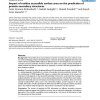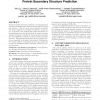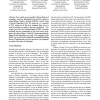JCB
2000
14 years 7 months ago
2000
We present a novel method for predicting the secondary structure of a protein from its amino acid sequence. Most existing methods predict each position in turn based on a local wi...
BMCBI
2004
14 years 7 months ago
2004
Background: RNA secondary structure prediction methods based on probabilistic modeling can be developed using stochastic context-free grammars (SCFGs). Such methods can readily co...
JCO
2007
14 years 7 months ago
2007
The 2-interval pattern problem over its various models and restrictions was proposed by Vialette (2004) for the application of RNA secondary structure prediction. We present an O(n...
BMCBI
2006
14 years 7 months ago
2006
Background: The accuracy of protein secondary structure prediction has steadily improved over the past 30 years. Now many secondary structure prediction methods routinely achieve ...
BMCBI
2006
14 years 7 months ago
2006
Background: The accuracy of protein secondary structure prediction has been improving steadily towards the 88% estimated theoretical limit. There are two types of prediction algor...
BMCBI
2008
14 years 7 months ago
2008
Background: The problem of accurate prediction of protein secondary structure continues to be one of the challenging problems in Bioinformatics. It has been previously suggested t...
BMCBI
2010
14 years 7 months ago
2010
Background: To understand an RNA sequence's mechanism of action, the structure must be known. Furthermore, target RNA structure is an important consideration in the design of...
BIOINFORMATICS
2010
14 years 7 months ago
2010
Motivation: Existing methods for protein sequence analysis are generally firstorder and inherently assume that each position is independent. We develop a general framework for int...
SIGIR
2004
ACM
15 years 28 days ago
2004
ACM
Protein secondary structure prediction is an important step towards understanding the relation between protein sequence and structure. However, most current prediction methods use...
CEC
2005
IEEE
15 years 1 months ago
2005
IEEE
New results are presented for the prediction of secondary structure information for protein sequences using Hidden Markov Models (HMMs) evolved using a Genetic Algorithm (GA). We a...



